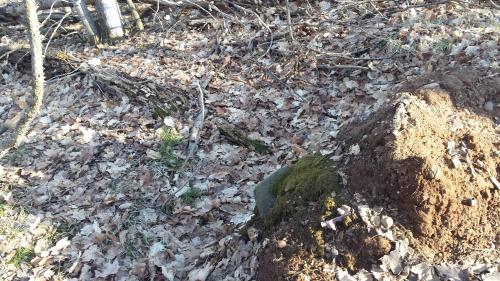Impact from blown down trees can leave lasting scars on the forest floor
Trees blown down or knocked over in wind events heave up mounds of dirt in root balls which remain long after the roots and stumps have decayed leaving irregular humps and divots throughout forested landscapes.

Unlike the relatively even topography of worked fields, many of our forest floors have rough and irregular landscapes. Humps and pockets permeate these stands making foot travel challenging and vehicle travel very difficult. Most of these irregularities to level ground were caused by wind events in bygone times.
When a tree gets blown over or knocked down, the roots tip up along with the attached soil. The amount of soil varies depending on the size and species of tree and the type of soil it is growing in. Over time the stem, base and roots will decay away, leaving a pile of soil adjacent to a hole that it was excavated from.
Eventually these piles erode from rain and wind events rounding them off. Vegetation will become established on the exposed soil leaving an irregular or mounded forest floor. Identified as pit and mound topography by many, woods workers refer to these mounded areas as “cradle knolls”. Legend has it that in nice weather, loggers would use these natural depressions, or cradles, to curl up in and take a nap out of the eyesight of their bosses.

Old root ball on the forest floor.
As destructive as these wind events can be, they offer some positive advantages to the forest ecology. Exposed bare soil creates needed seed bed conditions for some species of trees, shrubs and other plants. The irregularity which makes travel so challenging also creates microclimate conditions that contribute to successful regeneration and establishment of new plants and seedlings. Each “pile” has areas with greater sun exposure along with areas which are cooler and moister.
Different species of trees are adapted to these varied conditions and will take advantage of them to reestablish themselves. Maple, beech and hemlock for example are adapted to cooler moister conditions while oak, hickory and white pine are more likely found on dryer warmer soil.
Michigan State University Extension Bulletin #771 Tree Planting provides detailed information on preferred site requirements for native tree and shrub species. In addition to trees other plants, fungi and even some moisture loving vertebrates like salamanders and newts make use of the various microsites provided by these old tree mounds.
The next time you are stumbling along on a particularly rough forest floor think about the catastrophic event long ago that helped to create the situation. The forest and associated ecology there today was impacted by events that may have occurred eons ago.



 Print
Print Email
Email


